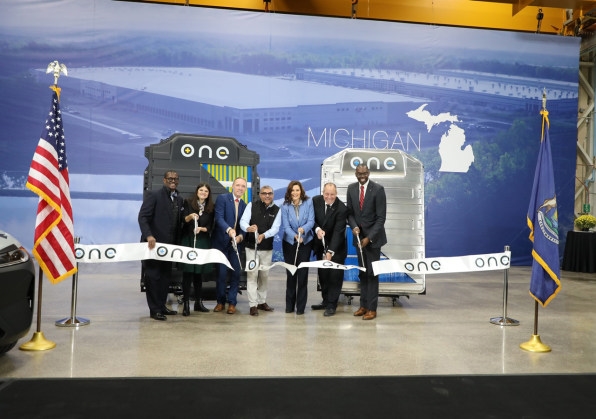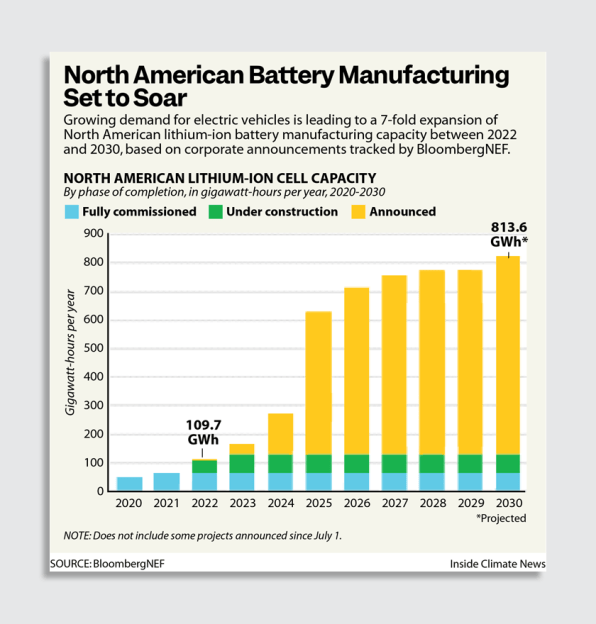The Midwest’s push to become an EV battery manufacturing hub
This article originally appeared on Inside Climate News. It is republished with permission. Sign up for their newsletter here.
Last week, Michigan Governor Gretchen Whitmer held a ceremonial ribbon-cutting at the headquarters of Our Next Energy, a battery manufacturing startup in Novi, a Detroit suburb.
This is an increasingly common scene as demand for electric vehicles is leading to an expansion of U.S. battery manufacturing on a scale so large that it’s almost difficult to comprehend.

Our Next Energy, or ONE, plans to spend $1.6 billion on a new plant in Novi that would employ more than 2,000 people. The company, co-founded by a former Ford engineer, is providing batteries to BMW, among others.
But that’s not even the biggest battery-related announcement in Michigan this month.
Gotion High Tech of China said on October 5 that it will spend $2.3 billion to build a plant that will make some of the components that go into batteries, and employ more than 2,300 people in Big Rapids in central Michigan.
BloombergNEF analysts have been monitoring all of the battery plant announcements and found that North America is in the process of going from a current capacity of 109.7 gigawatt-hours per year of lithium-ion batteries to a projected capacity of 813.6 gigawatt-hours per year in 2030—a seven-fold increase. (The Gotion High Tech plant isn’t part of the total because it makes battery parts, not finished batteries.)
This 2030 figure includes more than two dozen plants. A few of them are already operating but most are either under construction or are in some stage of pre-construction planning.
“We’re seeing a trend to localize the battery supply chain (and) we’re seeing automakers becoming battery manufacturers,” said Evelina Stoikou, an energy storage analyst for BloombergNEF.

The big players include Tesla and partnerships between automakers and battery companies, like BlueOval SK, which is owned by Ford and SK On of South Korea, and Ultium Cells, which is owned by General Motors and LG Energy Solutions of South Korea.
The largest plant announcement so far was last year, from BlueOval SK, which said it will spend $5.8 billion on a plant in Glendale, Kentucky with a capacity of 86 gigawatt-hours.
If all the plants get built, that would be enough battery capacity for more than 13 million EVs per year, based on the typical size range of today’s batteries. But not all of that capacity will be used for EVs, as some of those batteries will end up in battery storage systems and other uses.
The numbers come with some major caveats. The big one: Just because a plant is announced doesn’t mean it will be built, and doesn’t mean it will ever reach the level of employment and production in those initial news releases.
Also, the BloombergNEF’s totals don’t include several of the big projects that were announced in the last few months. In addition to ONE in Michigan, Panasonic said in July that it is spending $4 billion to build a battery plant in DeSoto, Kansas, that would employ up to 4,000 people. And Honda and LG said this month that their battery joint venture is spending $3.5 billion to build a battery plant near Jeffersonville, Ohio, that would employ up to 2,200 people.
The wave of projects shows that the auto industry has decided that EVs are the future and is planning accordingly. It also reflects some of the lessons learned from the COVID-19 pandemic as automakers saw the value of having the production of major components, like batteries, close to where vehicles are being manufactured.
The Inflation Reduction Act, signed by President Joe Biden in August, creates even more reasons for companies to make batteries in the United States. The law has incentives for clean energy manufacturing and says that a vehicle’s battery must be built in the United States to qualify for the full consumer tax credit of $7,500.
But it’s important to note that nearly all of the activity we’ve seen so far is based on plans that companies made before they knew the Inflation Reduction Act would pass or knew what would be in it.
So I expect even more announcements.
The growth will help the United States reduce the dominance of China and the Asia Pacific region in battery manufacturing, but the battery industry is also growing in that part of the world. Based on corporate announcements, North America would have 11 percent of global battery manufacturing capacity in 2030, and the Asia Pacific region will have 70 percent, according to BloombergNEF.
Back in Michigan, Whitmer was enjoying an economic development success story right in the final weeks of a re-election campaign.
“ONE is a Michigan-born-and-raised company on the cutting-edge of mobility and electrification,” Whitmer said in a statement. “The decision by this innovative company to keep its headquarters in Novi and establish a new manufacturing plant in Wayne County shows the world that Michigan is the place to build the future.”
(38)


